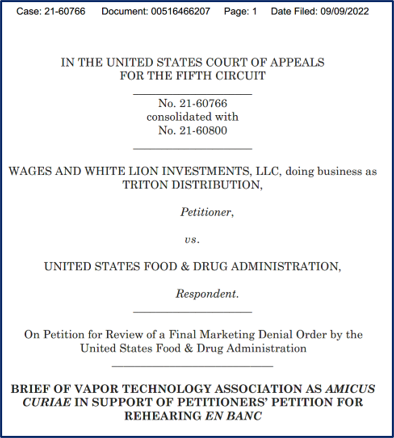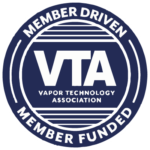The Vapor Technology Association has reviewed the U.S. Food and Drug Administration’s (FDA) Center for Tobacco Products (CTP) five-year strategic plan. In short, VTA is deeply disappointed with the plan’s lack of substance and absence of specifics to move American smokers off of combustible products towards effective harm-reduction nicotine options.
In October, at the Food & Drug Law Insitute’s Tobacco and Nicotine Policy Conference in Washington, D.C., VTA called on FDA to make harm reduction the “north star” of the strategic plan. The plan that has now been released lacks any commitment, much less a clear roadmap, to aggressively move people who smoke towards non-combustible forms of nicotine. It speaks vaguely about the importance of health equity and insists that a primary focus of CTP remains on reducing tobacco-related death and disease – but provides no insight, details, or specific methods by which CTP will achieve this. Nor does it acknowledge the latest science in support of e-cigarettes as the most effective non-combustible option for smoking cessation.
Most concerning is that CTP’s strategic plan fails to even attempt to address the Reagan Udall Foundation’s (RUF) central and most damning criticisms that go to the core of CTP’s job:
- that CTP has not clearly met the most basic elements of its tobacco and nicotine regulatory program by defining what is required of applicants under the “Appropriate for the Protection of the Public Health” (APPH) standard in the Tobacco Control Act, and
- that CTP has not clearly explained how it is assessing the science to determine what is APPH.
The silence of CTP’s strategic plan on these issues is defeaning. By failing to address these core criticisms, CTP’s five-year strategic plan will continue to generate misinformation, inefficiency, litigation, and suspicions of political interference.
VTA has repeatedly called on CTP to speak immediately, loudly, and repeatedly to adults about tobacco harm reduction in order to start saving lives now. Instead, CTP mentions the notion of conducting “foundational” and “formative” research on whether it might speak to adults – at some unknown time in the future – about harm reduction and less harmful vaping and other nicotine alternatives. Meanwhile, 480,000 people die prematurely every year from cigarette smoking.
The release of CTP’s five-year strategic plan, which took a full year to construct, was an opportunity to demonstrate bold, not bureaucratic, leadership on tobacco harm reduction that could close the deadly chapter of cigarettes in America. Instead, what the American public was given is document that reflected little more than a commitment to bureaucracy without any real direction or goals, much less a strategy to achieve those goals. Only 15 of the 27 pages of government pabulum (littered with pictures, graphics, and process tables) could actually be considered a recitation of the “plan” but, in total, it revealed nothing more than a “check the box” exercise (which failed to even check the most important boxes).
The strategic plan was a huge missed opportunity for the bureacracts to stand up for science and tobacco harm reduction, and stand up for the millions of smokers in vulnerable Black, LGBTQ+, and low income popluations who would benefit the most from a plan that actually kickstarted the important work of improving and saving lives and reducing or eliminating smoking related diseases. Instead, CTP demonstrated that its hands are firmly gripped upon a wheel that it is refusing to turn as it careens off a public health cliff with the lives of American smokers in tow.


